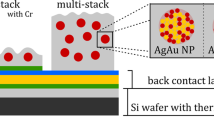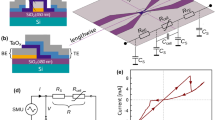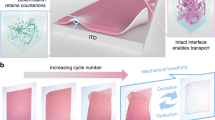Abstract
Resistive switches, which are also known as memristors, are low-power, nanosecond-response devices that are used in a range of memory-centric technologies. Driven by an externally applied potential, the switching mechanism of valence change resistive memories involves the migration, accumulation and rearrangement of oxygen vacancies within a dielectric medium, leading to a change in electrical conductivity. The ability to look inside these devices and understand how morphological changes characterize their function has been vital in their development. However, current technologies are often destructive and invasive. Here, we report a non-destructive optical spectroscopy technique that can detect the motion of a few hundred oxygen vacancies with nanometre-scale sensitivity. Resistive switches are arranged in a nanoparticle-on-mirror geometry to exploit the high optical sensitivity to morphological changes occurring in tightly confined plasmonic hotspots within the switching material. Using this approach, we find that nanoscale oxygen bubbles form at the surface of a strontium titanate memristor film, leading ultimately to device breakdown on cycling.
This is a preview of subscription content, access via your institution
Access options
Access Nature and 54 other Nature Portfolio journals
Get Nature+, our best-value online-access subscription
$29.99 / 30 days
cancel any time
Subscribe to this journal
Receive 12 digital issues and online access to articles
$119.00 per year
only $9.92 per issue
Buy this article
- Purchase on Springer Link
- Instant access to full article PDF
Prices may be subject to local taxes which are calculated during checkout




Similar content being viewed by others
Data availability
All source data for this work are available at https://doi.org/10.17863/CAM.55556.
References
Siemon, A. et al. Realization of Boolean logic functionality using redox-based memristive devices. Adv. Funct. Mater. 25, 6414–6423 (2015).
Valov, I., Waser, R., Jameson, J. R. & Kozicki, M. N. Electrochemical metallization memories—fundamentals, applications, prospects. Nanotechnology 22, 289502 (2011).
Waser, R. & Aono, M. Nanoionics-based resistive switching memories. Nat. Mater. 6, 833–840 (2007).
Bernard, Y., Renard, V. T., Gonon, P. & Jousseaume, V. Back-end-of-line compatible conductive bridging RAM based on Cu and SiO2. Microelectron. Eng. 88, 814–816 (2011).
Das, M., Kumar, A., Singh, R., Htay, M. T. & Mukherjee, S. Realization of synaptic learning and memory functions in Y2O3 based memristive device fabricated by dual ion beam sputtering. Nanotechnology 29, 055203 (2018).
Niu, D., Chen, Y., Xu, C. & Xie, Y. Impact of process variations on emerging memristor. In Proceedings of the 47th Design Automation Conference 877–882 (Association for Computing Machinery, 2010); https://doi.org/10.1145/1837274.1837495
Kwon, D.-H. et al. Atomic structure of conducting nanofilaments in TiO2 resistive switching memory. Nat. Nanotechnol. 5, 148–153 (2010).
Chen, J.-Y. et al. Dynamic evolution of conducting nanofilament in resistive switching memories. Nano Lett. 13, 3671–3677 (2013).
Choi, B. J. et al. Resistive switching mechanism of TiO2 thin films grown by atomic-layer deposition. J. Appl. Phys. 98, 033715 (2005).
Szot, K., Speier, W., Bihlmayer, G. & Waser, R. Switching the electrical resistance of individual dislocations in single-crystalline SrTiO3. Nat. Mater. 5, 312–320 (2006).
Yang, J. J. et al. The mechanism of electroforming of metal oxide memristive switches. Nanotechnology 20, 215201 (2009).
Das, M. et al. Effect of surface variations on the performance of yttria based memristive system. IEEE Electron Device Lett. 39, 1852–1855 (2018).
Ahmed, T. et al. Inducing tunable switching behavior in a single memristor. Appl. Mater. Today 11, 280–290 (2018).
Sun, B. et al. The effect of current compliance on the resistive switching behaviors in TiN/ZrO2/Pt memory device. Jpn J. Appl. Phys. 48, 04C061 (2009).
Krishnan, K., Aono, M. & Tsuruoka, T. Kinetic factors determining conducting filament formation in solid polymer electrolyte based planar devices. Nanoscale (2016); https://doi.org/10.1039/C6NR00569A
Menzel, S., Böttger, U., Wimmer, M. & Salinga, M. Physics of the switching kinetics in resistive memories. Adv. Funct. Mater. 25, 6306–6325 (2015).
Tappertzhofen, S., Menzel, S., Valov, I. & Waser, R. Redox processes in silicon dioxide thin films using copper microelectrodes. Appl. Phys. Lett. 99, 203103 (2011).
Hubbard, W. A. et al. Nanofilament formation and regeneration during Cu/Al2O3 resistive memory switching. Nano Lett. 15, 3983–3987 (2015).
D’Aquila, K., Liu, Y., Iddir, H. & Petford-Long, A. K. In-situ TEM study of reversible and irreversible electroforming in Pt/Ti:NiO/Pt heterostructures. Phys. Status Solidi Rapid Res. Lett. 9, 301–306 (2015).
Yang, Y. & Lu, W. D. Progress in the characterizations and understanding of conducting filaments in resistive switching devices. IEEE Trans. Nanotechnol. 15, 465–472 (2016).
Di Martino, G., Tappertzhofen, S., Hofmann, S. & Baumberg, J. Nanoscale plasmon-enhanced spectroscopy in memristive switches. Small 12, 1334–1341 (2016).
Emboras, A. et al. Atomic scale photodetection enabled by a memristive junction. ACS Nano 12, 6706–6713 (2018).
Emboras, A. et al. Atomic scale plasmonic switch. Nano Lett. 16, 709–714 (2016).
Waser, R. Nanoelectronics and Information Technology: Advanced Electronic Materials and Novel Devices (Wiley, 2012).
Valov, I. Interfacial interactions and their impact on redox-based resistive switching memories (ReRAMs). Semicond. Sci. Technol. 32, 093006 (2017).
Cho, S. et al.Self-assembled oxide films with tailored nanoscale ionic and electronic channels for controlled resistive switching. Nat. Commun. 7, 12373 (2016).
Baumberg, J. J., Aizpurua, J., Mikkelsen, M. H. & Smith, D. R. Extreme nanophotonics from ultrathin metallic gaps. Nat. Mater. 18, 668–678 (2019).
Ranjan, A. et al. Analysis of quantum conductance, read disturb and switching statistics in HfO2 RRAM using conductive AFM. Microelectron. Reliab. 64, 172–178 (2016).
Aravind, P. K. & Metiu, H. The effects of the interaction between resonances in the electromagnetic response of a sphere-plane structure; applications to surface enhanced spectroscopy. Surf. Sci. 124, 506–528 (1983).
Nordlander, P. & Prodan, E. Plasmon hybridization in nanoparticles near metallic surfaces. Nano Lett. 4, 2209–2213 (2004).
Lian, X. et al. Multi-scale quantum point contact model for filamentary conduction in resistive random access memories devices. J. Appl. Phys. 115, 244507 (2014).
Long, S. et al. Quantum-size effects in hafnium-oxide resistive switching. Appl. Phys. Lett. 102, 183505 (2013).
Cartoixà, X., Rurali, R. & Suñé, J. Transport properties of oxygen vacancy filaments in metal/crystalline or amorphous HfO2/metal structures. Phys. Rev. B 86, 165445 (2012).
Mertens, J. et al. Tracking optical welding through groove modes in plasmonic nanocavities. Nano Lett. 16, 5605–5611 (2016).
Mertens, J. et al. Controlling subnanometer gaps in plasmonic dimers using graphene. Nano Lett. 13, 5033–5038 (2013).
Tserkezis, C. et al. Hybridization of plasmonic antenna and cavity modes: extreme optics of nanoparticle-on-mirror nanogaps. Phys. Rev. A 92, 053811 (2015).
Demetriadou, A. et al. Spatiotemporal dynamics and control of strong coupling in plasmonic nanocavities. ACS Photonics 4, 2410–2418 (2017).
Pflüger, J. & Fink, J. in Handbook of Optical Constants of Solids (ed. Palik, E. D.) Ch. 13, 293–311 (Academic Press, 1997); https://doi.org/10.1016/B978-012544415-6.50055-8
Pflüger, J., Fink, J., Weber, W., Bohnen, K. P. & Crecelius, G. Dielectric properties of TiCx, TiNx, VCx and VNx from 1.5 to 40 eV determined by electron-energy-loss spectroscopy. Phys. Rev. B 30, 1155–1163 (1984).
Kos, D. et al. Electrically controlled nano and micro actuation in memristive switching devices with on-chip gas encapsulation. Small 14, 1801599 (2018).
Li, Y. et al. Nanoscale chemical and valence evolution at the metal/oxide interface: a case study of Ti/SrTiO3. Adv. Mater. Interfaces 3, 1600201 (2016).
Clark, S. J. et al. First principles methods using CASTEP. Z. Kristallogr. (2005); https://doi.org/10.1524/zkri.220.5.567.65075
Morris, A. J., Nicholls, R. J., Pickard, C. J. & Yates, J. R. OptaDOS: a tool for obtaining density of states, core-level and optical spectra from electronic structure codes. Comput. Phys. Commun. 185, 1477–1485 (2014).
Acknowledgements
G.D.M. acknowledges support from the Winton Programme for the Physics of Sustainability. J.J.B. acknowledges funding from EPSRC grant no. EP/L027151/1 and NanoDTC EP/L015978/1, and W.L. and J.M.-D. from EPSRC grants nos. EP/L011700/1, EP/N004272/1 and EP/P007767/1 and the Isaac Newton Trust. A.D. acknowledges support from a Royal Society University Research Fellowship URF/R1/180097 and Royal Society Research Fellows Enhancement Award RGF/EA/181038. B.d.N. acknowledges support from the Leverhulme Trust and the Isaac Newton Trust in the form of an ECF. The US–UK collaborative effort was funded by the US National Science Foundation (ECCS-1902644 (Purdue University) and ECCS-1902623 (University at Buffalo, SUNY)) and EPRSC grant no. EP/T012218/1. J.M.-D. also acknowledges funding from the UK Royal Academy of Engineering, grant no. CiET1819_24. B.Z. acknowledges support from the China Scholarship Council and Cambridge Commonwealth, European and International Trust.
Author information
Authors and Affiliations
Contributions
Experiments were devised by G.D.M. and J.J.B. and performed by G.D.M., with support for the chemical nanoassembly and sample preparation from D.K. The custom-made cantilever contacting set-up was realized by D.K. W.L. synthesized the STO/TiN films, performed X-ray diffraction and atomic force microscopy, with support from X.W. and H.W. for the TEM measurements. DFT calculations were performed by B.Z., guided by W.L., and FDTD simulations by A.D. The data analysis was performed by G.D.M., with support from all authors. The manuscript was written with contributions from all authors.
Corresponding authors
Ethics declarations
Competing interests
The authors declare no competing interests.
Additional information
Publisher’s note Springer Nature remains neutral with regard to jurisdictional claims in published maps and institutional affiliations.
Supplementary information
Supplementary Information
Supplementary Figs. 1–16 and sections A–H.
Rights and permissions
About this article
Cite this article
Di Martino, G., Demetriadou, A., Li, W. et al. Real-time in situ optical tracking of oxygen vacancy migration in memristors. Nat Electron 3, 687–693 (2020). https://doi.org/10.1038/s41928-020-00478-5
Received:
Accepted:
Published:
Issue Date:
DOI: https://doi.org/10.1038/s41928-020-00478-5
This article is cited by
-
3D-integrated multilayered physical reservoir array for learning and forecasting time-series information
Nature Communications (2024)
-
Integrated optical memristors
Nature Photonics (2023)
-
Enhancement in electrical conductivity of liquid crystals by graphene metal oxide composites
Scientific Reports (2023)
-
Highly light-tunable memristors in solution-processed 2D materials/metal composites
Scientific Reports (2022)
-
Recent advances on crystalline materials-based flexible memristors for data storage and neuromorphic applications
Science China Materials (2022)



